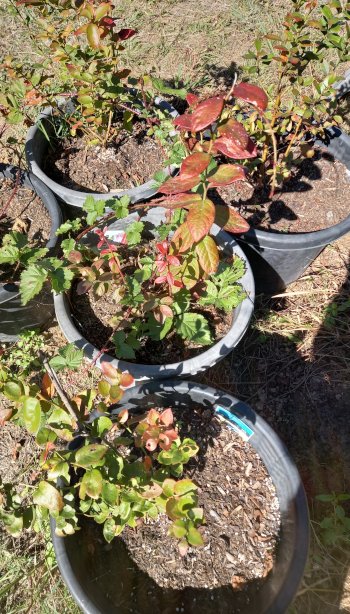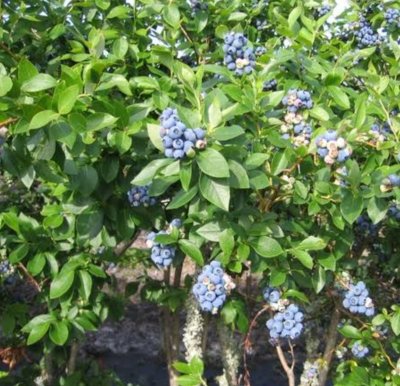Blueberries are a hardy plant and red leaves do happen in very healthy bushes from time to time so don't go overboard with solutions until you actually know there is a problem. Test your soil's acidity once every year or two with a simple kit which can be purchased, keep an eye on moisture in soil and be aware of temperature. Just observe for a while because the plant will tell you what it needs. If a normal, healthy plant in good soil conditions suddenly has red leaves, its usually not much to be concerned about. If leaves start turning yellow and drop, that is a potential 'problem'.
Many people opt to plant in containers because the soil pH is easier to control, etc, and the pot can be moved.
The picture here is of my blueberries which are sitting in a holding area until I prepare their permanent spot. They are approx four to five months old and were extremely healthy and 'green' until around three weeks ago when I got busy and a bit slack with watering plus the drop in winter temperature. The main problem l saw was that the young plants did not adapt to changes easily and the dry soil resulting in all four plants turning as red as the centre pot. Once they had a good drink, most started reverting back to green and the remaining red is most likely the cold temperatures.
WHAT TO LOOK FOR
- AGE OF PLANT
First thing to ask is how old is the bush. A newly planted or very young bush could simply be going through some transplant shock and reacting to some environmental changes such as weather, temperature, soil conditions and water to name a few and the plant will right itself once established. Check the following points and, if all are covered, just keep an eye on it and it should right itself in time with some TLC. A more established plant will tolerate sporadic changes and adapt. - TEMPERATURE
One of the main reasons is change of seasons. Blueberries are a very cold hardy perennial but will react with red leaves to a sudden drop in temperature. If your soil and other factors are correct, this is nothing to be overly concerned about. If they are grown in pots, they can be moved to a more sheltered, warmer position over winter. - WATER
Blueberries like a damp (but not wet) soil and drought / soil drying out is not ideal for optimum performance. If allowed to dry out, the plant has a hard time drawing up nitrogen and phosphorus, two essential elements. - ACIDIC SOIL 5 to 5.5 pH
Blueberries require an acidic soil also to uptake nutrients and to grow to a good harvest. Always do a pH test on soil before amending to ensure the acidity is actually the problem.<br />
Sphagnum peat moss, powdered or pelletised sulphur are two ways to acidify an alkaline soil. - LACK OF NUTRIENTS
An older plant is more likely to be affected as it has already absorbed the surrounding nutrients. Blueberries, unlike other plants, show a nitrogen deficiency with red leaves where other plants indicate with yellow leaves. Amend the soil with compost, liquid fertiliser, compost tea, etc. - PESTS
Aphids or spider mites are the two likely causes and both such the sap from leaves causing stress and red leaves.
Enjoy growing your blueberry plants, grow several and enjoy the harvest of these highly nutritious fruit 😋
🌱 Happy Gardening 🌱

